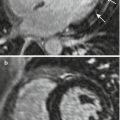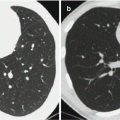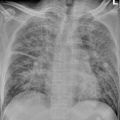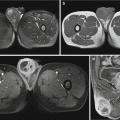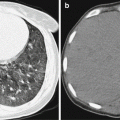Fig. 10.1
Gonorrhea in male. (a, b) Purulent secretions at urethral meatus (Note: The figures were provided by Sun X at the Department of Dermatology, You’an Hospital, Beijing, China.)
10.4.2 Gonorrhea in Females
About 50 % of the female patients with gonorrhea are asymptomatic or slightly affected and, therefore, tend to be neglected. Its onset in females is commonly at the cervix and may also be found at the vagina, urethra, or rectum.
Gonococcal cervicitis is clinically characterized by increased and abnormal vaginal secretions that are initially mucous and then purulent. There are also mild odynuria, urgent urination, and difficult urination. By routine examination, swelling and tenderness are found at the cervical opening with yellowish purulent secretions. Gonococcal urethritis is characterized by redness and swelling at the urethral meatus. Pus can be pressed out from the paraurethral gland in patients with skenitis. Gonococcal bartholinitis is characterized by unilateral redness, swelling, and pain of the greater vestibular gland, abscess caused by occluded duct, and fever.
Vagina of girls is composed of columnar epithelial cells, and, therefore, they are vulnerable to infection of gonococcus. Infection commonly occurs after close contacts to or sharing the same bathroom appliances with infected parents. In some rare cases, the infection is caused by sexual abuse. Clinically, it is characterized by swelling and burning pain of vulva as well as purulent secretion in vagina.
10.4.3 Gonococcal Anorectitis
The disease is more common in homosexual males (accounting for 40 %), and female patients are often self-infected by vaginal secretions (accounting for 5 %). About 50 % of the patients are asymptomatic, and others may experience anal pruritus and burning sensation. In severe cases, the patients experience tenesmus, bloody purulent stool, and constipation. By examination of anus and rectum, the mucosa can be found with congestion, edema, and purulent secretion.
10.4.4 Gonococcal Pharyngitis
Its occurrence is comparatively common after oral sex, with manifestations of acute pharyngitis or acute tonsillitis. Clinically, it is characterized by dry and sore throat, odynophagia, sometimes accompanying fever, and cervical lymphadenectasis.
10.4.5 Gonococcal Conjunctivitis
Its autoinfection is common in adult patients, which is usually unilateral. Neonates are commonly infected when they are delivered through the birth canal of the infected mother; their symptoms develop 2–3 days after the delivery and are usually bilateral. The initial symptom is usually purulent conjunctivitis, which may, if without prompt appropriate treatment, rapidly develop into destructive keratitis and corneal opacity, even blindness.
10.4.6 Disseminated Gonococcal Infection
It is a systemic infection of gonococcus caused by dissemination of the bacteria all over the body along with blood flow. And its incidence is 1–3 %, more common in females (accounting for about 2/3) during menstrual period and middle and late gestation periods. It also can be found in individuals with deficiency of complement components C5–C9 (accounting for less than 5 %). It may be manifested as gonococcal septicemia, arthritis, peritendinitis, myocarditis, endocarditis, and meningitis.
10.5 Gonorrhea-Related Complications
10.5.1 Gonorrhea-Related Complications in Males
Gonococcal urethritis in males, if without prompt appropriate treatment, can develop upward to involve the posterior urethra, causing posterior urethritis, prostatitis, cystospermitis, and epididymitis. Scars formed after repeated attacks of inflammation can cause urethral stenosis. In some cases, stricture or obstruction of seminiferous duct occurs, with secondary sterility.
10.5.1.1 Gonococcal Prostatitis
The occurrence of acute gonococcal prostatitis is more common at the third week after the onset of gonorrhea with manifestations of fever, shiver, perineal pain, and dysuria. Rectal examination demonstrates prostate enlargement with tenderness which may cause abscess if left untreated. Patients with chronic prostatitis are mild and their secretions are often found around the urethral opening in the morning. Rectal examination can touch relative harshness of prostate and node with tenderness. And examination of prostatic fluid bears the findings of the epithelial cells, few pus cells, and a decrease of lecithin-b.
10.5.1.2 Gonococcal Vesiculitis
During acute phrase of the disease, patients have manifestations of fever, frequent micturition, dysuria, terminal cloudy urine with blood, and sometimes accompanying semen retention. Rectal examination can reach the swollen seminal vesicle with severe tenderness. No obvious subjective symptoms are found in patient with chronic vesiculitis, while sometimes accompanying hematospermia. Rectal examination can reach the hard part of vesiculitis.
10.5.1.3 Gonococcal Epididymitis
The occurrence of gonococcal epididymitis commonly follows acute gonococcal urethritis. It is usually unilateral with manifestations of fever, scrotal swelling, epididymal swelling, and pain. Initially, there is ill-defined area with testicles which gradually become indistinct, reflective throbbing pain in contralateral groin and hypogastrium, and commonly cloudy urine. At the same time, there are often accompanying prostatitis and vesiculitis.
10.5.1.4 Urethral Stenosis
Patients with persistent symptoms may cause urethral stenosis. Individual cases may sustain stricture or obstruction of the vas deferens with dysuria. In severe cases, urinary retention is also found. The disease also can secondary to stricture of vas deferens, cystis vesiculae seminalis, and sterility.
10.5.2 Gonorrhea-Related Complications in Females
The disease is commonly caused by non-prompt treatment of gonococcal cervicitis with uplink infection of the inflammation.
10.5.2.1 Gonococcal Pelvic Inflammation
The factors that contribute to pelvic abscess and peritonitis include acute salpingitis, endometrial inflammation, secondary tubal ovarian abscess, and rupture. The occurrence of the disease often follows menstruation with the incidence of 10–20 %. The clinical manifestations are various and dominant pictures include fever, shiver, hypogastralgia, increased purulent leucorrhea, and thickness of bilateral adnexa with tenderness. Repeated outbreak can cause stenosis or obstruction of the ovarian ducts as well as ectopic pregnancy and sterility.
10.5.2.2 Fitz-Hugh-Curtis Syndrome (FHCS)
FHCS is a kind of capsule inflammation which is caused by pelvic infection delivering to hepatic layer via right paracolic sulci with manifestation of right upper quadrant pain syndrome. Clinically, according to pathological changes of FHCS, the disease can be divided into two types, acute FHCS and chronic FHCS. Acute FHCS has symptoms of slightly exudative inflammation on the liver surface, congestion and edema of liver capsula, spots of hemorrhages, and fibrous exudation. While in chronic phrase, zonary adhesion between liver surface and abdominal wall, thickness of liver capsula are visible.
Acute episode of right upper quadrant pain is the typical manifestation of FHCS which may radiate into the back; the pain gets worse when patients breathe deeply or cough accompanying fever, nausea, vomiting, sudden increased secretion of nearby vagina. Physical examination demonstrates obvious tenderness in right upper quadrant. Pelvic adnexal tenderness and abscess may be found or are absent.
10.6 Diagnostic Examinations
10.6.1 Laboratory Test
10.6.1.1 Smear Examination
Gram stain of vaginal discharge demonstrates gram-negative diplococcus in polymorphonuclear leukocyte. It is suitable for the diagnosis of patients with acute urinary-tract infection with sensitivity and specificity both over 95 %. The examination is not recommended for the diagnosis of oropharynx and rectum which are infected and gonococcal cervicitis.
10.6.1.2 Culture Examination
Cultivation method is sensitive to both male and female patients with mild symptoms or asymptomatic carriers. The diagnosis can be defined when cultivation is positive. Before the introduction of genetic diagnosis, cultivation method is the only method for the screening of gonorrhea recommend by the World Health Organization.
10.6.1.3 Drug Sensitive Test
Drug sensitive test was operated after positive culture. The application of disk diffusion for drug sensitive test or agar dilution method can detect the minimum inhibitory concentration for the purpose to guide clinical medication.
10.6.1.4 Gene Diagnosis
Gene Probe Diagnosis
The probes applied include plasmid DNA probe, chromosomal gene probe, and rRNA gene probe.
Gene Diffusion Test
PRC can further improve the accuracy to detect gonococcus with advantage of rapidity, sensitivity, specificity, and simplicity. And it can directly detect trace amounts of pathogens in clinical specimens.
10.6.2 Imaging Examination
10.6.2.1 Ultrasound
Ultrasound can be used for the examination and diagnosis of gonorrhea-related complications for its noninvasiveness, practicability, and relative high accuracy.
10.6.2.2 CT Scanning
CT scanning is unsuitable for the examination of scrotum or testes for the radiation damage to gonad caused by X-ray, but it is appropriate for the diagnosis of pelvic inflammation and hepatitis externa.
10.6.2.3 MRI
MRI is often used for the examination of gonorrhea-related complications especially for pelvic organs and gonad.
10.7 Imaging Demonstrations
10.7.1 Acute Prostatitis
10.7.1.1 Ultrasound
Two-Dimensional Ultrasonography
1.
Prostate enlarges slightly or obviously featuring bilateral symmetric or asymmetry.
2.
The echo of envelope is clear and complete. There may be an exception to individual patients with prostatic abscess rupture.
3.




Inter echo is a little low and uneven. The occurrence of suppuration accompanies low echo or uneven enhancement, and small no echo area is visible. Typical prostatic abscess has manifestations of ill-defined interstructure of parenchyma, irregular low echo, and anecho area with indication of liquid flow.
Stay updated, free articles. Join our Telegram channel

Full access? Get Clinical Tree




